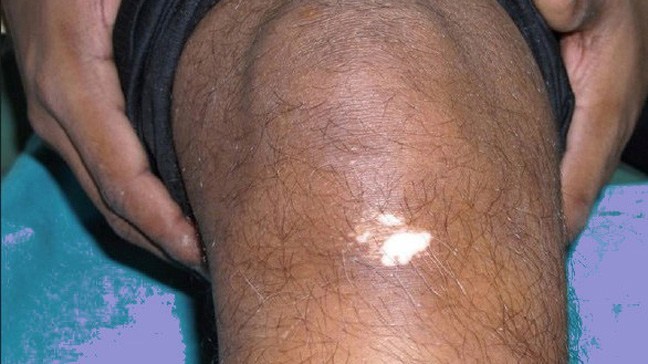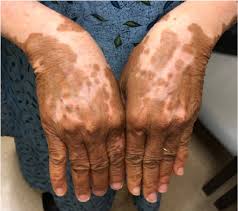Vitiligo is a chronic skin condition characterized by depigmentation ( loss of colour) that occurs in about 1 percent of the world’s population. It can affect any area of the skin including the insides of the mouth and nose. The areas of skin most commonly affected are the face, neck and hands. It affects all skin types but is more noticeable in people with darker skin.

CAUSES
The exact cause of vitiligo is unknown but it is said to be due to destruction of melanocytes which are the cells that produce melanin responsible for giving the skin it’s colour. Why these cells are destroyed is unclear but a common hypothesis is that it is due to changes in the immune system whereby the body’s immune system fights against itself (autoimmunity). As a result of this, the cells responsible for pigmentation (melanocytes) are destroyed.
Genetics could play a role in vitiligo even though it doesn’t seem to be inheritable. However, a family history of vitiligo coupled with other autoimmune conditions can increase the risk of having it. It can also be triggered by emotional or physical stress.
SYMPTOMS
Vitiligo begins as white patches generally on the skin of the hand, face and neck. Sometimes, these patches then spread to other parts of the body with the affected areas more sensitive to sunlight. It does not spread from person to person ( non communicable).
Depending on the appearance and areas affected, vitiligo can be classified into segmental and non-segmental vitiligo
SEGMENTAL VITILIGO
It is also known as focal, localized or unilateral vitiligo. Just like it’s name suggests, segmental vitiligo affects one side of the body. It progresses at a much slower rate than non segmental vitiligo and the patches tend to be smaller. It is also less common and prevalent in teenage years. Its relationship with autoimmune diseases is also not as strong as with non-segmental vitiligo.
NON-SEGMENTAL VITILIGO
It is also known as generalized or bilateral vitiligo. It can occur on any part of the body and it tends to be symmetrical. It is closely related to other autoimmune conditions. It is also more common than segmental vitiligo. Unlike the latter, it can occur at any age.
Other classifications list vitiligo as one of the following;
Focal: Just a few patches scattered in one region

Mucosal: The depigmentation of the mucosa of the nose or mouth
Acrofacial: Only the fingers and facial regions are affected
Trichrome: The patches are characterized with a white or somewhat colourless center
Generalized: Patches are randomly distributed on different parts of the body
Universal: The patches cover almost every part of the body
DIAGNOSIS
Your doctor might request for a blood sample to carry out tests to rule out any autoimmune condition since there might be an association. A biopsy of the affected part or an ultraviolet (UV) photograph of the part thought to be affected might be done to help distinguish it from other skin conditions.
Treatment
There is no known cure for vitiligo yet. But there are several management strategies
- Use of creams containing steroids to restore a little colour to the affected areas. But note that these creams can also cause stretch marks and other side effects. It should not be applied to the face
- Use of sunscreen when outdoors to reduce sensitivity to sunlight
- Ultraviolet B ( UVB) phototherapy. This could restore pigmentation to an extent, but not fully
- Use of cosmetics to camouflage the affected areas
- Depigmentation of unaffected areas to match the patches. This is a very effective method but bleaching of the skin could make the skin more fragile. So, put your skin type and the quality of products to be used into consideration
- Skin grafting
Due to the sociocultural implications, vitiligo can cause an individual to develop low self esteem, anxiety and even depression especially if it is present on visible parts of the body. Opening up to family and friends and your physician can help the patient feel better. Also, do not stigmatize people you see with the condition nor draw unnecessary attention to them. VITILIGO IS NOT CONTAGIOUS.

Oyewole Ibukun is currently a Medical student of Olabisi Onabanjo University. She has a passion for seeking knowledge with a creative, detail oriented and analytical mindset.


